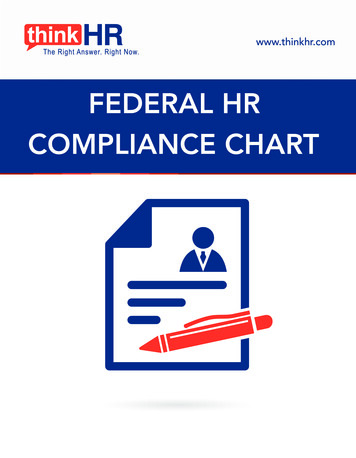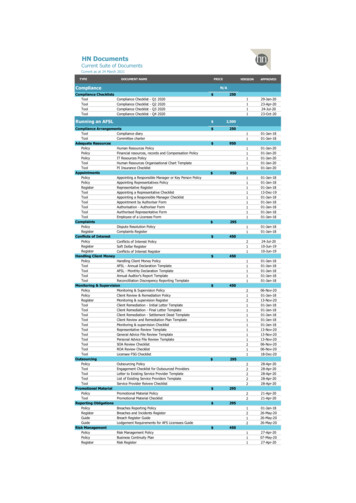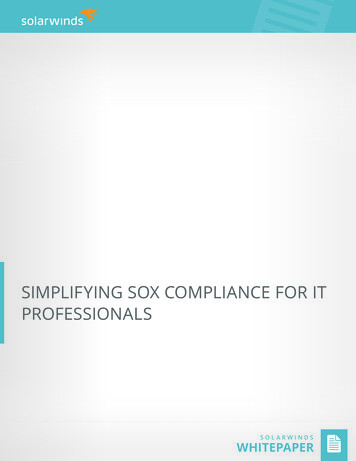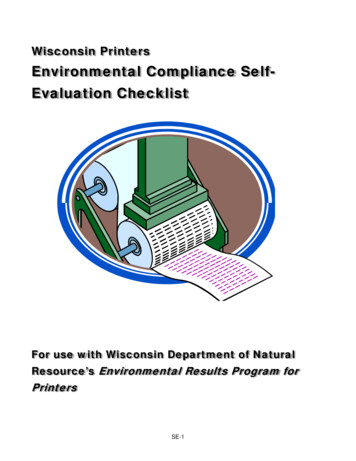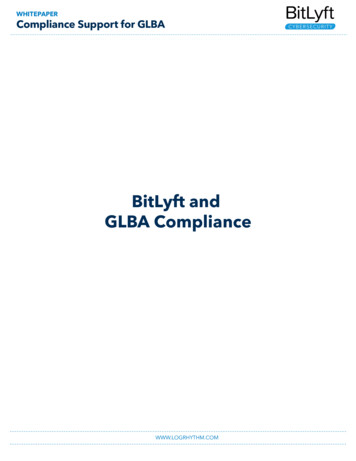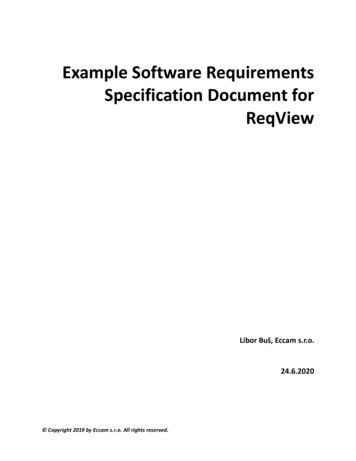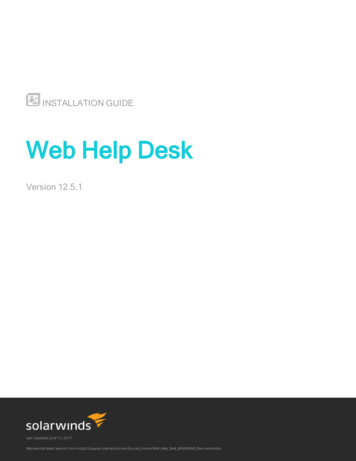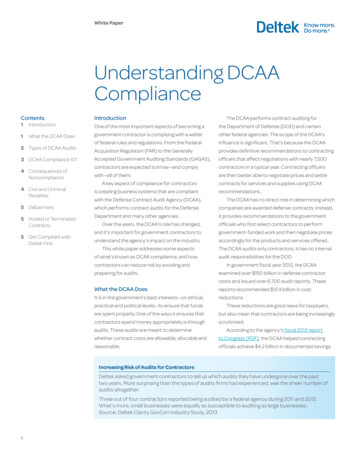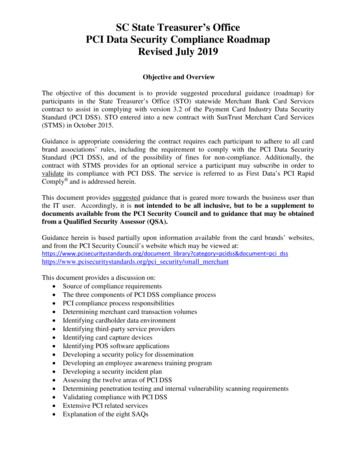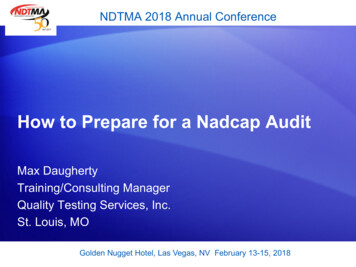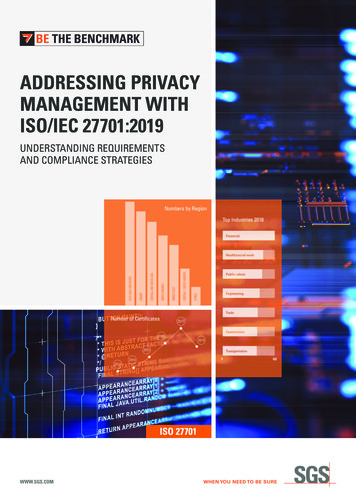
Transcription
BE THE BENCHMARKADDRESSING PRIVACYMANAGEMENT WITHISO/IEC 27701:2019UNDERSTANDING REQUIREMENTSAND COMPLIANCE STRATEGIESNumbers by RegionTop Industries 2018Number of Certificates2017201620182015201302014ISO 27701WWW.SGS.COM400
CONTENTS1.2.3.4.5.6.OVERVIEW .3THE ISO/IEC 27701:2019 STANDARD .3PRIVACY INFORMATION MANAGEMENT .6CERTIFICATION AND ACCREDITATION .7OTHER PRIVACY STANDARDS .8WHY SGS? .8
3OVERVIEWA rapid increase in concerns over privacy relating to social media apps and IoT devices and the global proliferation of privacylaws and regulations mean organizations are now facing pressure from customers, end-users, investors, and regulatorsabout how they manage the personal identifiable information (PII), or personal data, they collect when conducting theirbusiness. The enactment of many wide-influence privacy laws, such as the EU General Data Protection Regulation (GDPR),the California Consumer Privacy Act (CCPA), and the China Cybersecurity Law, has imposed significant pressure onorganizations to look at the issue of privacy.The concept of privacy is often misunderstood and/or incorrectly acted upon. Many organizations believe it is enough tonot pass data on to third parties and ensure their databases are password protected. Concepts such as ‘consent’, ‘purposeof collection’, or ‘cross-border transfer’ are either ignored or not understood. The fierce penalties of GDPR and CCPA finesmean many organizations are now waking up to the risks and are finally beginning to pay proper attention to their privacyprotection.This white paper introduces the ISO/IEC 27701:2019 standard, discusses its structure and how it can be used to implementa Personal Information Management System (PIMS), and certification against the standard.The intended audience of this white paper is: Organizations looking for general information about a PIMS; and Organizations planning to implement or to get certified for a PIMS against ISO/IEC 27701:2019
4THE ISO/IEC 27701:2019 STANDARDISO/IEC 27701:2019 – Security Techniques -- Extension to ISO/IEC 27001 and ISO/IEC 27002 for privacy informationmanagement -- requirements and guidelines – specifies the requirements and gives guidance for establishing, implementing,maintaining and continually improving a Privacy Information Management System (PIMS) in the form of an extension to ISO/IEC 27001 and ISO/IEC 27002 for privacy management within the context of the organization.It is designed to work with ISO/IEC 27001 and is a combination of certifiable requirements and implementation guidelines.It is also an extension to ISO/IEC 27001, adding PIMS-related requirements such as clause 5, Annex A and Annex B. Theserequirements are shall statements – 67 in total in the standard. Additionally, the standard also adds guidance for PIMS inISO/IEC 27002 – e.g. clauses 6, 7 and 8.The structure of the standard is summarized in Table 1.TABLE 1. STRUCTURE OF THE ISO/IEC 27701:2019 STANDARD AND ITS CONNECTION WITH ISO/IEC 27001 AND ISO/IEC 27002CLAUSECLAUSE TITLEREMARK1ScopeApplicability of the Standard2Normative referencesStandard references3Terms, definitions and abbreviations4GeneralDescription of the structure of the Standard5PIMS-specific requirements related to ISO/IEC 27001PIMS-specific requirements for requirementsin ISO/IEC 270016PIMS-specific guidance related to ISO/IEC 27002PIMS-specific guidance for controls in ISO/IEC 270027Additional ISO/IEC 27002 guidance for PII controllersAdditional ISO/IEC 27002 guidance for PIIcontrollers8Additional ISO/IEC 27002 guidance for PII processorsAdditional ISO/IEC 27002 guidance for PIIprocessorsAnnex AAnnex A (normative) PIMS-specific reference control objectives and controls (PIIControllers)Applicable and mandatory controls for datacontrollersAnnex BPIMS-specific reference control objectives and controls (PII Processors)Applicable and mandatory controls for dataprocessorsAnnex CMapping to ISO/IEC 29100Non certifiable, informative annexesAnnex DMapping to the General Data Protection RegulationAnnex EAnnex E (informative) Mapping to ISO/IEC 27018 and ISO/IEC 29151Annex FHow to apply ISO/IEC 27701 to ISO/IEC 27001 and ISO/IEC 27002SO 27701 REQUIREMENTSSCOPENORMATIVEREFERENCESTERMS &DEFINITIONSGENERALPIMSISO/IEC 27001PIMSISO/IEC27002PIICONTROLLERSEach clause outlines necessary requirements and steps that must be met before certification is granted.PIIPROCESSORS
5CLAUSE 5Clause 5 covers additional requirements to clauses 4 to 10 of ISO/IEC 27001:2013 and they are all certifiable. For example,clause 5.7.2 states:“The requirements stated in ISO/IEC 27001:2013, 9.2, along with the interpretation specified in 5.1 apply”This standard does not add any new requirements for internal audits, as long as the organization understands that‘information security’ in ISO/IEC 27001:2013 should be interpreted as extending to include the risks resulting fromprocessing Personal Identifiable Information (PII).ISO/IEC 27701:2019 has additional requirements for the following ISO/IEC 27001 clauses:4.1Understanding the organization and its context4.2Understanding the needs and expectations of interested parties4.3Determining the scope of the information security management system6.1.2Information security risk assessment6.1.3Information security risk treatmentCLAUSE 6Clause 6 covers additional PIMS-related guidance for ISO/IEC 27002. For example, clause 6.9.4.4 (corresponding to 12.4.4Clock Synchronization of ISO/IEC 27002:2013) does not contain any additional requirements because clock synchronizationhas little relevance to privacy risks. On the other hand, clause 6.9.3.1 (corresponding to 12.3.1 Information backup of ISO/IEC 27002:2013) has lengthy guidance because there can be privacy risks relating to information backup, such as dataretention periods, cross-border data transfer, etc.The following table summarizes the number of controls in each domain of ISO/IEC 27002. There is a total of 32 new controlsamending ISO/IEC 27002. As with ISO/IEC 27002, guidance in clause 6 is non-certifiable.CLAUSE IN ISO/IEC 27002# OF CONTROLS AMENDEDCLAUSE IN ISO/IEC 27002# OF CONTROLS AMENDED5112362132711458515193162101170112184CLAUSE 7This clause provides guidance for PII controllers, with the controls being listed in Annex A of the standard. These controlsare normative, meaning they are to be implemented if the organization is certified to be a controller (see PII Controller vsPII Processor under Certification below). The guidance provided in Clause 7 assists an organization in implementing thesecontrols. This guidance is non-certifiable.CLAUSES# OF CONTROLSA.7.2Conditions for collection and processing8 controlsA.7.3Obligations to PII principals10 controlsA.7.4Privacy by design and by privacy default9 controlsA.7.5PII sharing, transfer and disclosure4 controls
6CLAUSE 8Clause 8 provides guidance for PII processors. The controls for PII processors are listed in Annex B of the standard. Similarto Annex A, these controls are normative if the organization is certified to be a processor. The guidance in clause 8 is noncertifiable.CLAUSES# OF CONTROLSB.8.2Conditions for collection and processing6 controlsB.8.3Obligations to PII principals1 controlB.8.4Privacy by design and by privacy default3 controlsB.8.5PII sharing, transfer and disclosure8 controlsPRIVACY INFORMATION MANAGEMENT SYSTEM VSINFORMATION SECURITY MANAGEMENT SYSTEMWhile ISO/IEC 27001 – Information Security Management (ISMS) – provides useful insights into managing informationsecurity it does not have sufficient controls on data privacy. This means an organization can pass an ISMS audit without fullyaddressing applicable privacy regulatory obligations.PIMS differs from a typical ISMS in several ways (see Table 2).TABLE 2. DIFFERENCES BETWEEN A TYPICAL ISMS AND PIMSISMSPIMSOrganizational scopeOrganizations may implement their ISMSto cover only their IT operations. The scopetherefore only covers departments thatdirectly impact IT operations, e.g. IT, facilities,security, human resources, etc.Many departments not directly related to IToperations may collect and process PIIs (orpersonal data), especially from customersand end users, e.g. marketing, customerservices, sales, etc.Information/data covered in the scopeThe ISMS typically protects the organization'sown data, e.g. business plans, intellectualproperty, proprietary engineering data. Itcould just be established to ensure theintegrity and availability of an organization'sinformation systems, e.g. data center.A PIMS covers all PIIs collected andprocessed by an organization, includingemployees, visitors, customers, and endusers. It therefore covers data which mightnot be covered under the ISMS.Focuses on confidentiality, integrity, andavailability (CIA) of the information/data beingprotected. Even if PIIs are included in anISMS, the focus is usually on their CIA, e.g.whether they are properly protected, stored,transferred, and retrieved.Goes beyond CIA for PIIs. Many globalprivacy regulations include privacy principles,e.g. whether PIIs are collected lawfully, orused solely for their original purposes. Theymay also include data subject ‘rights’, e.g.the right to be informed, the right to rectifya PII, the right to object to direct marketing,etc. The PIMS contains provisions to handlethese requirements which are often absentin an ISMS.Protection focus
7CERTIFICATION AND ACCREDITATIONCERTIFICATIONSGS offers certification against ISO/IEC 27701:2019 for organizations which are already certified to ISO/IEC 27001:2013 orwill be certified concurrently with ISO/IEC 27001:2013.Organizations that are certified to ISO/IEC 27001:2013 need to review the scope of their ISMS and ensure it is either thesame or larger than the planned scope of the PIMS. This review is important as the scope of many ISMS covers only the ITand/or associated departments while the PIMS covers all departments that collect and process PIIs (see Privacy InformationManagement System vs Information Security Management System for explanation).If the scope of the ISMS is smaller than that of the PIMS, it will need to be extended to match the PIMS’s scope (see Figure 1).FIGURE 1. EXAMPLE OF A POSSIBLE EXTENSION OF THE ISMS TO SERVE AS THE FOUNDATION OF THE PIMSINTENDED PIMSORIGINAL CUSTOMERSERVICESDEPARTMENTINTENDED PIMSINTENDED CUSTOMERSERVICESDEPARTMENT
8PII CONTROLLER VS PII PROCESSORAs described in earlier sections, the standard contains controls for both PII controllers and PII processors. In theory, anyorganization can act as controller and processor at the same time (see Table 3 for two examples).When complying with regulations such as GDPR, an organization will need to fulfill the obligations of both roles. Under ISO/IEC 27701 certification, an organization can choose to be certified as controller, processor, or both. By selecting a particularrole, however, the organization is not relieved of its full legal obligation. Therefore, the decision to certify as controller,processor, or both, should be based on the organization’s business needs and management decision. The role to be certifiedwill be stated on the certificate.TABLE 3. EXAMPLES OF AN ORGANIZATION IS BOTH A PII CONTROLLER AND A PII PROCESSORSCENARIOEXAMPLEORGANIZATION MAY ALSO PERFORM BOTH ROLESAn organization acting as PIIprocessor for its customersData center serving as the IaaS platform for aSaaS customer.The data center is also a PII controller when collectingthe visitor’s PII at the data center entrance – includingCCTV footage of visitors. The data center also acts asPII controller for its employees.An organization acting as PIIcontrollerThe website of a big data analytics firm thatallows visitors to subscribe to their newsletterby providing an email address.The firm analyses behavioral data passed to themfrom its customers it is hence a PII processor for itscustomers' PII.OTHER PRIVACY STANDARDSPrior to ISO/IEC 27701:2019, several ISO/IEC standards were available and many of them are still valid.STANDARDDESCRIPTIONREMARKISO/IEC 29151:2017Code of practice for PII protection 36 additional guidance in ISO/IEC 27002 13 additional controls on PIIISO/IEC 27018:2019Code of practice for protection of PII in publicclouds acting as PII processors 15 additional guidance in ISO/IEC 27002related to PII in cloud 11 additional cloud based PII controlsThese two standards were released before the introduction of GDPR, CCPA, etc. but they do not contain all the provisionsrequired for these regulations (e.g. automatic decision making and profiling). ISO/IEC 29151 ISMS or ISO/IEC 27018 ISMS were also not designed to be a PIMS. They add only the controls and do not contain the additional requirements tobe added to the ISMS, such as a data privacy policy, data processing risk assessment, etc., that allow an organization toimplement a PIMS. At the time of writing, these two standards are still valid.Organizations are encouraged to evaluate their management needs before selecting the approach best suited to their strategy.WHY SGS?SGS is the world’s leading inspection, verification, testing and certification company. SGS is recognised as the globalbenchmark for quality and integrity. With more than 89,000 employees, SGS operates a network of over 2,600 offices andlaboratories around the world.We provide competitive advantage, drive sustainability and deliver trust. At SGS, we are continually pushing ourselves todeliver innovative services and solutions that help our customers move their businesses forward.Efficiency and cost-optimization are no longer the sole drivers in business development strategies. Successful businessesrecognize the importance of offering their workforce continuous development and training. Motivated and effective teamscreate industry leaders.
CONTACT terwww.sgs.com/linkedincertification@sgs.com
ISO/IEC 27002 – e.g. clauses 6, 7 and 8. The structure of the standard is summarized in Table 1. TABLE 1. STRUCTURE OF THE ISO/IEC 27701:2019 STANDARD AND ITS CONNECTION WITH ISO/IEC 27001 AND ISO/IEC 27002 CLAUSE CLAUSE TITLE REMARK 1 Scope Applicability of the Standard 2 Normat
